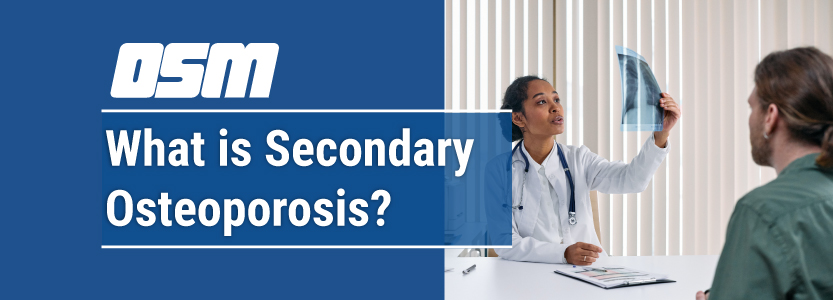What is Secondary Osteoporosis?
Article featured on MedicalNewsToday
Osteoporosis is a bone disease that involves a loss of bone density. It causes the bones to become more fragile and prone to fractures. Secondary osteoporosis develops either as a result of a medical condition or as a side effect of a medication.
Osteoporosis affects about 10 million people in the United States. The disease may be primary or secondary. Primary osteoporosis occurs as a result of the natural aging process, whereas secondary osteoporosis occurs due to other reasons.
This article describes the difference between primary and secondary osteoporosis. It also outlines the possible causes of secondary osteoporosis and provides information on the symptoms, diagnosis, and treatment options.
Primary vs. secondary osteoporosis
Doctors categorize osteoporosis into primary and secondary osteoporosis.
Primary osteoporosis is a consequence of the aging process. In females, hormones such as estrogen and progesterone decline after menopause. These hormones are essential for healthy bones, and when their levels are low, the body becomes less able to produce new, healthy bone tissue.
Secondary osteoporosis develops when an underlying medical condition or the use of a certain medication interferes with the body’s ability to produce new bone tissue.
Causes of secondary osteoporosis
Secondary osteoporosis may develop when certain medical conditions or medications interrupt the formation of new bone tissue. An imbalance between the loss of old bone and the production of new bone leads to a lower bone turnover rate. The result is a loss of bone density.
Medical conditions
Medical conditions that may lead to secondary osteoporosis include:
- hyperparathyroidism
- hyperthyroidism
- diabetes
- inflammatory bowel disease (IBD)
- rheumatoid arthritis
- lupus
- celiac disease
- chronic kidney disease
- liver disease
- ankylosing spondylitis
- multiple myeloma
- multiple sclerosis (MS)
- anorexia nervosa
Medications
In most cases, secondary osteoporosis occurs as a result of taking certain medications, which include those below.
Hormones and medications that affect the endocrine system
The endocrine system is a network of glands that produce and secrete hormones for a wide range of bodily functions. Hormones and other medications that affect the endocrine system may cause secondary osteoporosis. Examples include:
- thyroid hormone
- glucocorticoids
- thiazolidinediones
- hypogonadism-inducing agents:
- aromatase Inhibitors
- medroxyprogesterone acetate
- gonadotropin-releasing hormone (GnRH) agonists
Medications that affect the immune system
The immune system consists of various organs, cells, and proteins that work together to protect the body from pathogens and toxins. Medications that affect the immune system may cause secondary osteoporosis. Examples include antiretroviral therapy and calcineurin inhibitors.
Medications that act on the central nervous system
The central nervous system (CNS) consists of the brain and spinal cord. Medications that affect the CNS can increase the risk of secondary osteoporosis. These include anticonvulsants and antidepressants.
Medications that affect the gastrointestinal tract
The gastrointestinal tract consists of all the organs involved in the digestive process. Medications that affect the gastrointestinal tract can increase the risk of secondary osteoporosis. An example is proton pump inhibitors, which reduce the production of stomach acid.
Symptoms
People with osteoporosis are usually unaware that they have the condition, as they typically do not experience any symptoms. Often, people only receive a diagnosis of osteoporosis following a bone break from a fall or sudden impact.
The most common injuries associated with osteoporosis are:
- broken hip
- broken wrist
- broken vertebrae
As the bones become increasingly fragile, people may experience fractures in other parts of the body. Seemingly harmless activities, such as sneezing or coughing, can sometimes cause these fractures.
Some older people with the condition may develop a stooped posture due to bone fractures within the spine.
Diagnosis
A doctor will perform a thorough medical examination to look for conditions that may cause secondary osteoporosis. They will also take a full medical history to help identify any medications that may be associated with the condition.
Simple screening procedures can help identify possible causes of secondary osteoporosis. These procedures may include:
- testing blood or other bodily fluids for the following:
- metabolic bone markers
- protein
- electrolytes
- blood cell count
- creatinine
- calcium
- alkaline phosphates
- liver enzymes
- blood tests to assess thyroid function
- DEXA or ultrasound scans to assess bone density
The Orthopedic & Sports Medicine Center of Oregon is an award-winning, board-certified orthopedic group located in downtown Portland Oregon. We utilize both surgical and nonsurgical means to treat musculoskeletal trauma, spine diseases, sports injuries, degenerative diseases, infections, tumors and congenital disorders.
Our mission is to return our patients back to pain-free mobility and full strength as quickly and painlessly as possible using both surgical and non-surgical orthopedic procedures.
Our expert physicians provide leading-edge, comprehensive care in the diagnosis and treatment of orthopedic conditions, including total joint replacement and sports medicine. We apply the latest state-of-the-art techniques in order to return our patients to their active lifestyle.
If you’re looking for compassionate, expert orthopedic surgeons in Portland Oregon, contact OSM today.
Phone:
503-224-8399
Address
1515 NW 18th Ave, 3rd Floor
Portland, OR 97209
Hours
Monday–Friday
8:00am – 4:30pm




